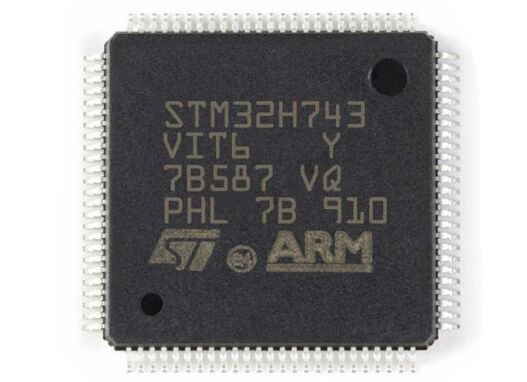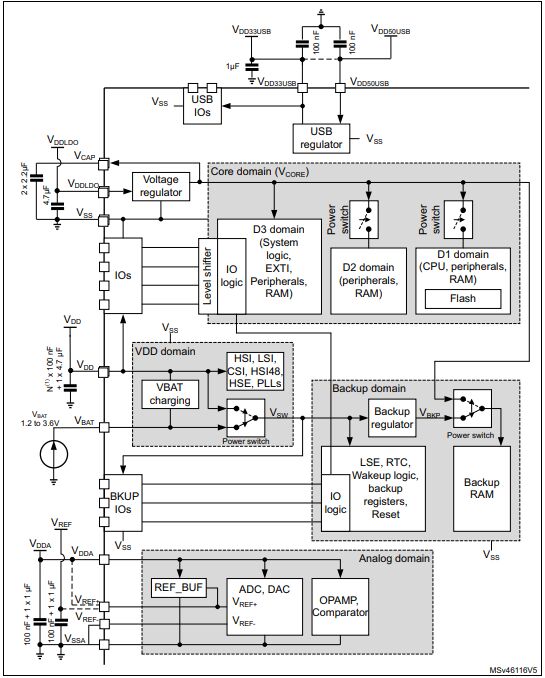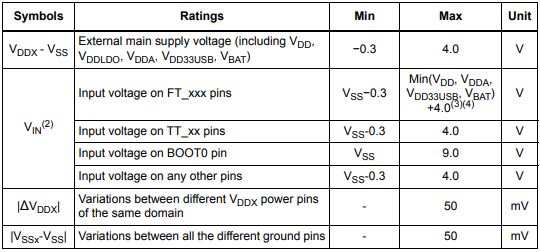By STMicroelectronics 116
STM32H743VIT6 is a 32-bit microcontroller unit (MCU) based on the ARM Cortex-M7 core launched by STMicroelectronics. It belongs to the STM32 series of STMicroelectronics. This series is one of the 32-bit microcontroller series based on the ARM architecture.
STM32H743VIT6 usually has a higher clock frequency to provide faster data processing capabilities. Performance parameters usually include clock frequency, memory size (Flash and RAM), operating temperature range, etc. Due to its high performance and rich peripherals, this device is widely used in applications requiring higher computing performance, such as industrial control, automotive sub-medical equipment, communication equipment, etc.
The STM32H743VIT6 microcontroller uses the ARM Cortex-M7 core, a high-performance, low-power 32-bit RISC processor core. Cortex-M7 provides higher performance and more powerful computing power in the STM32 series. The main features of this model include high-performance processor, rich peripheral interfaces, high-speed memory and various communication interfaces. Some common features may include multiple USARTs, SPI, 12C interface, general timers, DMA controller, etc.

Ⅰ.Specifications of STM32H743VIT6
•Products:MCUs
•Number of pins:100
•Package:Tray
•Humidity Sensitivity:Yes
•Installation style:SMD/SMT
•Package/Case:LQFP-100
•Supply voltage-Minimum:1.71 V
•Supply voltage-Max:3.6 V
•Data bus width:32 bit
•Core:ARM Cortex M7
•Program memory size:2 MB
•ADC resolution:3 x 16 bit
•Maximum clock frequency:480 MHz
•Data RAM size:1 MB
•Minimum operating temperature:-40℃
•Maximum operating temperature:+85℃
•DAC resolution:12 bit
•Data Ram type:RAM
•Number of input/output terminals:82 I/O
•I/O voltage:1.71V to 3.6V
•Number of ADC channels:20 Channel
•Product category:ARM microcontroller-MCU
•Number of pins:100
•Oscillator type:Internal
•Product life cycle:Active
•Program memory type:flash memory
•Data converter:A/D 36x16b;D/A 2x12b
•Product type:ARM Microcontrollers-MCU
•Watchdog Timer:Watchdog Timer, Windowed
•Interface type:CAN, I2C, SAI, SDIO, SPI, USART, USB
Ⅱ.Features of STM32H743VIT6
•VBAT battery operating mode with charging capability
•Dedicated USB power supply embedded with 3.3 V internal regulator to power the internal PHY
•Supports multiple communication interfaces, such as SPI, I2C, UART, etc., as well as high-speed USB interface to achieve fast data transmission
•Flexible external memory controller with up to 32-bit data bus: SRAM, PSRAM, SDRAM/LPSSDR SDRAM, NOR/NAND flash, clock frequency up to 100 MHz in synchronous mode
•Supports multiple low-power modes to extend battery life and is suitable for battery-powered or low-power application scenarios
•Equipped with high-performance ADC and DAC (digital-to-analog converter and analog-to-digital converter), which can realize high-precision acquisition and output of analog signals, and is suitable for various analog signal processing applications
•STM32H743VIT6 uses the ARM Cortex-M4 core with a main frequency of up to 100MHz and has efficient instruction execution and data processing capabilities. At the same time, it also integrates an FPU (Floating Point Unit), which is suitable for applications that require floating point operations.
•1×Basic DMA with request router functionality for up to 35 communication peripherals
•2×USB OTG interface with LPM and BCD (1FS, 1HS/FS) crystal-free solution
•3×ADC, maximum resolution 16 bits (up to 36 channels, up to 3.6 MSPS)
•Chrom ART graphics hardware accelerator (DMA2D) to reduce CPU load
•2.95µA in standby mode (backup SRAM off, RTC/LSE on) clock management
•3 independent power domains with independent clock gating or shutdown: –D1: high-performance capabilities; –D2: communication peripherals and timers; –D3: reset/clock control/power management
Ⅲ.Application scenarios of STM32H743VIT6
1.Automotive electronics: STM32H743VIT6 can meet the requirements for microcontrollers in the automotive electronics field, such as high temperature resistance and vibration resistance. It can be used in various electronic control systems of automobiles, such as engine control systems, brake control systems, etc.
2.Communication equipment: In the field of communication, STM32H743VIT6 can be used to realize the control and data processing of various communication equipment, including wireless communication equipment, network equipment, routers, etc. Its high performance and rich communication interfaces enable it to handle large amounts of data and support multiple communication protocols.
3.Smart home: Smart home requires a large number of sensors, controllers and communication interfaces. STM32H743VIT6's multiple peripheral interfaces and low power consumption features are very suitable for controlling and monitoring various smart home devices and systems.
4.Medical equipment: STM32H743VIT6 can meet the requirements of medical equipment for microcontrollers, such as high-precision measurement, low power consumption, etc. Can be applied to various medical equipment, such as monitors, ultrasound equipment, etc.
5.Industrial control: The various peripheral interfaces of STM32H743VIT6 can easily connect various sensors and actuators to realize various functions of the industrial control system. At the same time, its efficient data processing capabilities and low power consumption also make it an ideal choice in the field of industrial control.
6.Instrumentation: Instrumentation requires high-precision, high-performance processors and rich peripheral interfaces. The STM32H743VIT6's high-performance ADC and DAC and various peripheral interfaces can meet the design needs of most instrumentation.
Ⅳ.Power supply scheme of STM32H743VIT6

Ⅴ.Voltage characteristics of STM32H743VIT6

Ⅵ.Configure the development environment of STM32H743VIT6
1.Install an integrated development environment (IDE): Choose an appropriate integrated development environment. Commonly used ones include Keil MDK, IAR Embedded Workbench, STM32CubeIDE, etc. These IDEs all provide support for the STM32 series microcontrollers, making it easy to write, debug and download code.
2.Install STM32CubeMX: STM32CubeMX is a graphical configuration tool provided by STMicroelectronics, which can help users quickly configure the pin assignments, peripheral settings, etc. of the STM32 microcontroller. Usually, it is integrated with IDE and can be used to generate initialization code framework.
3.Install the compiler and debugging tools: Depending on the IDE you choose, you need to install the corresponding compiler and debugging tools. For example, if you use Keil MDK, you need to install the ARM Keil C compiler and ULINK debugger.
4.Select and download the relevant documents and software packages of STM32H743VIT6: Download the reference manual, data manual, technical documentation, etc. of the STM32H7 series from the official website of STMicroelectronics, as well as the software packages for the STM32H7 series (such as HAL library, LL library, etc.).
5.Create a new project: Create a new project in the IDE and select STM32H743VIT6 as the target device. During the project creation process, you can use STM32CubeMX to generate initialization code and set pin assignments, peripheral configuration, etc.
6.Write and debug code: Write application code in the IDE and debug it. You can use the debugging tools provided by the IDE (such as single-step debugging, breakpoint settings, etc.) to debug the code, and download the program to the STM32H743VIT6 microcontroller through the debugger for running.
7.Build and download the program: Build the project in the IDE and use the debugger to download the program to the target device. The debugger and target device can be connected via USB and the program can be downloaded to the STM32H743VIT6’s internal flash memory.
Ⅶ.Precautions when using STM32H743VIT6
1.Development environment: The development environment of STM32H743VIT6 can use integrated development environments (IDEs) such as Keil MDK and IAR Embedded Workbench, or you can use the STM32CubeMX tool officially provided by ST for rapid configuration and development.
2.Power management: The power supply voltage range of STM32H743VIT6 is 1.8V to 3.6V, and the stability and reliability of the power supply need to be ensured.
3.Peripheral configuration: STM32H743VIT6 provides a variety of peripheral interfaces, and you need to select the appropriate interface for configuration and use according to specific application scenarios.
4.Program debugging: The program debugging of STM32H743VIT6 can be debugged using the JTAG or SWD interface, or you can use tools such as ST-Link for online debugging and burning.
Ⅷ.Current characteristics of STM32H743VIT6

Ⅸ.STM32H743VIT6 alternative model
•STM32H753ZIT6
•STM32H757
•STM32H745
•STM32F767
•STM32F767
•STM32H7A3VIT
Frequently Asked Questions
1.What is the main processor core used in STM32H743VIT6?
STM32H743VIT6 utilizes the ARM Cortex-M7 core.
2.What development tools are available for STM32H743VIT6?
Development tools for STM32H743VIT6 include STM32CubeMX for graphical configuration, STM32CubeIDE for integrated development environment, and various compilers/debuggers compatible with ARM Cortex-M7 architecture.
3.How does STM32H743VIT6 ensure security for embedded applications?
STM32H743VIT6 incorporates hardware encryption modules, secure boot, secure storage areas, and other security features to protect embedded applications and data.
4.What are the power consumption characteristics of STM32H743VIT6?
STM32H743VIT6 offers various low power modes to minimize power consumption, making it suitable for battery-powered or low-power applications.